Adenium plants, commonly known as desert roses, are a popular type of succulent plant known for their colorful flowers and unique swollen trunks. These plants originate from arid regions of Africa and Arabia but can be grown in gardens and as houseplants around the world. In this comprehensive guide, we will explore the different types of adenium plants, their care requirements, and how to choose the right variety for your needs.
Overview of Adenium Plants
Adeniums belong to the Apocynaceae family along with other succulents like plumeria and oleander There are around 12 recognized adenium species with Adenium obesum being the most popular Adeniums are appreciated for their thick caudices that store water, drought tolerance, colorful blooms, and bonsai-like shapes. They require full sun, well-draining soil, warm temperatures, and minimal watering to thrive.
Some key features of adenium plants include:
- Thick, fleshy leaves and stems to retain water
- Swollen trunk bases called caudices
- Showy flowers in shades of red, pink, white, yellow
- Slow growth rate
- Bonsai-like shapes
- Drought resistance
- Originate from arid regions of Africa and Arabia
Common Adenium Varieties
There are several adenium species and cultivars available Here are some of the most popular types you may encounter
Adenium Obesum
The most common and widespread variety. Native to southwest Africa. Features large caudices, round rubbery leaves, and showy blooms in various colors. The most popular for bonsai.
Adenium Arabicum
Native to the Arabian Peninsula Broad shrub with large, leathery leaves. Caudices are less pronounced. Excellent for bonsai.
Adenium Somalense
A rare species from Somalia. Distinguished by bottle-shaped trunks and large pink or white flowers.
Adenium Swazicum
From South Africa. Larger than A. obesum with extra tolerance to weather fluctuations.
Adenium Socotranum
Resembles a miniature baobab tree. From Socotra island. Can grow over 10 feet tall with bottle-shaped trunks.
Adenium Boehmianum
Also called “bushman’s poison.” Has long, spindly branches and sparse flowers. Named after the plant’s use in poison arrows.
Adenium Multiflorum
A miniature adenium growing under 12 inches tall. Produces abundant small blooms. Great for containers.
Growing Conditions for Adeniums
While adeniums are resilient plants, they do require specific care to thrive:
Sunlight
Adeniums require full sun – at least 4-6 hours of direct sun daily. Insufficient light leads to sparse blooms and leggy growth. Rotating indoor plants helps prevent one-sided growth.
Soil
Fast-draining soil is crucial to prevent rot in adeniums. A mix of sand, perlite, and peat moss provides an ideal balance.
Water
Water thoroughly only when the soil dries out. Adeniums store water in their caudices and are very drought tolerant. Too much moisture causes rotting.
Temperature & Humidity
Adeniums prefer warm temperatures between 70-90°F. They also appreciate 40-50% humidity. Mist leaves or use a humidity tray to increase moisture.
Fertilizer
Use a balanced fertilizer (10-10-10) diluted to half strength during the growing season. Overfertilizing can damage adeniums.
Choosing the Right Adenium Variety
With dozens of adenium species and cultivars available, selecting the right one for your needs takes some consideration:
-
Growing conditions – Match the adenium variety to your climate. A. obesum and A. swazicum are very tolerant.
-
Mature size – Smaller species like A. multiflorum suit containers while larger varieties become focal trees.
-
Growth habit – Upright, spreading, or bottle-shaped habits offer different aesthetic options.
-
Flower characteristics – Select adeniums based on preferred bloom size, color, and abundance.
-
Caudex shape – Varieties have distinct caudex shapes from round (A. obesum) to tapered (A. socotranum).
-
Hardiness – Some adeniums like A. swazicum tolerate more weather fluctuations.
-
Rarity – Consider common varieties or rare collector’s items like A. somalense.
Caring for Adenium Plants
Once you’ve selected the right adenium variety, proper care is vital for the health and longevity of your plant:
-
Plant in fast-draining cactus/succulent soil with extra perlite or pumice.
-
Water thoroughly only when the top few inches become dry. Reduce water in winter.
-
Provide at least 4-6 hours of direct sun daily. Rotate indoor plants for even sun exposure.
-
Keep humidity around 40-50% and avoid excess moisture on leaves.
-
Fertilize monthly in the growing season with a balanced diluted fertilizer.
-
Prune leggy growth and shape when needed. Make cuts close to nodes.
-
Repot every 2-3 years in spring, moving only to a slightly larger container.
-
Bring outdoor adeniums indoors if temperatures drop below 50°F.
-
Watch for pests like mealybugs and scale. Treat promptly with horticultural oils or insecticidal soap.
With proper selection, care, and growing conditions adeniums can thrive for years. Their colorful blooms and sculptural shapes make them a standout addition to any succulent collection.
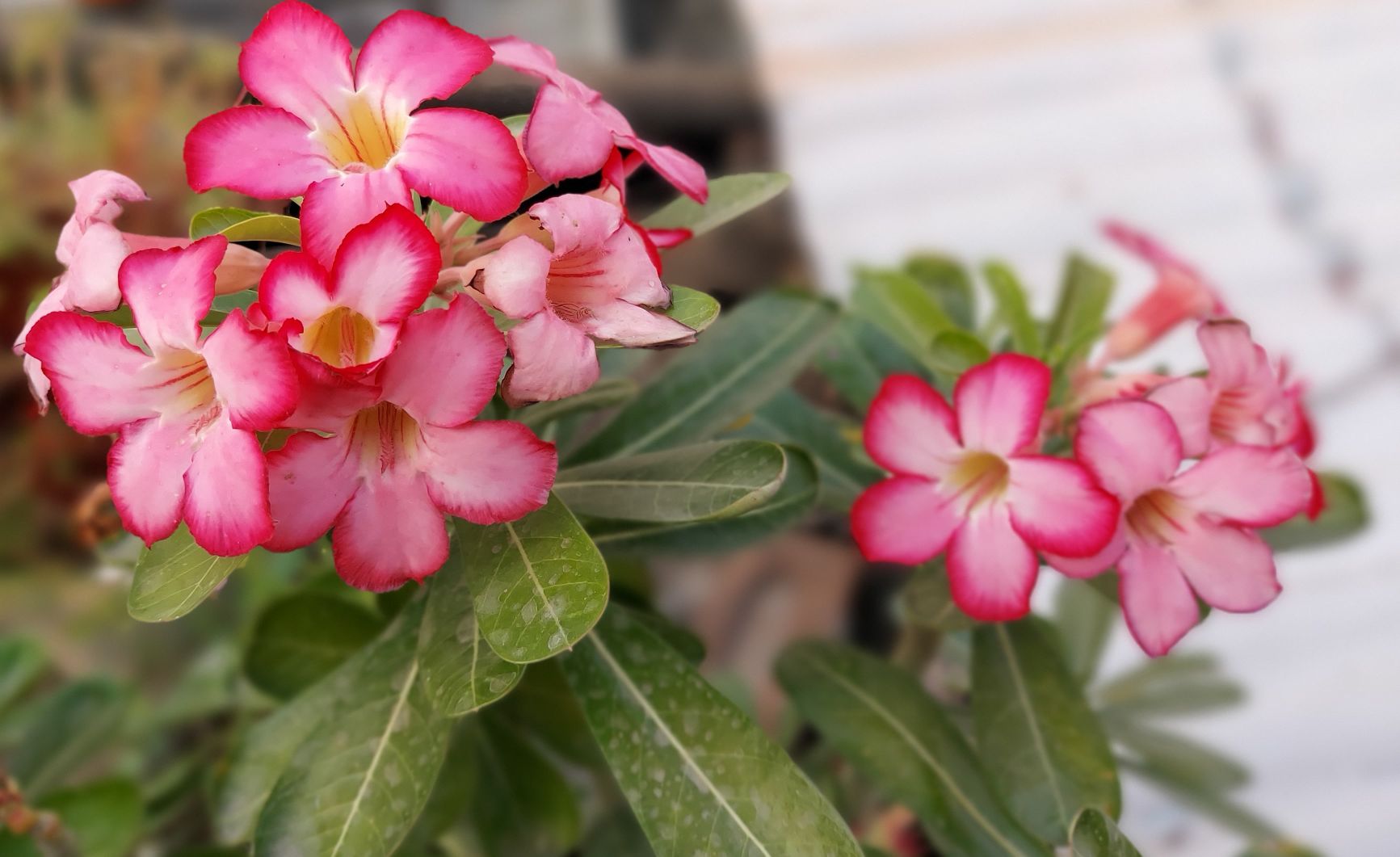
Adenium Roem. & Schult.
Family: Apocynaceae
Common names: A. boehmianum : pylgif (Afr.); ouzuwo (Herero). A. multiflorum : impala lily, Sabi star, kudu lily ( Eng. ); impalalelie (Afr.). A. obesum : desert rose ( Eng. ). A. oleifolium : ouheip (Afr.). A. swazicum : summer-flowering impala lily, rathbonia ( Eng. )
Adeniums, which all have poisonous sap, produce flowers in striking reds, pinks and mauves; red-and-white bicoloured flowers are fairly common. They are interesting caudiciform plants and make ideal container subjects. Known to occur in more arid regions, adeniums are sensitive to frost and waterlogged soils. The plants are usually deciduous during winter or the dry season. South African species of Adenium do well in warmer gardens and their rather handsome flowers make them an attractive addition to a garden.
Adenium is a small genus of succulent shrubs that produce swollen stems, often with peculiar forms. When the starry flowers appear in masses, the appearance of the plant is completely transformed. The genus exhibits a great deal of natural variation in the form of the stems, form and colour of the flowers, and overall size. Over the past 20 years, adeniums have been grown by several breeders world-wide, selecting superior variations and producing a large range of cultivars. Adenium is closely related to Pachypodium but is distinguished by the absence of stipules at the base of the leaves which develop into long rigid spines. The genus is not to be confused with Adenia (Passifloraceae, granadilla family) which also has caudiciform stems or rootstocks, but they are green and the stems are usually twining.
Adenium This is a genus of deciduous succulent shrublets, shrubs or small trees. The smooth, fleshy, swollen stems are sometimes entirely subterranean with only fleshy branches above ground. The plants have tubers or rootstocks and usually clear sap. The striking, showy flowers are carried in few-flowered clusters at the tips of branches and range from white, pink, red to purple and white edged crimson. Leaves are alternate or in simple spirals, often in terminal clusters, and are sessile or have short stalks. The corolla is funnel- or cup-shaped, with a cylindrical tube. The part of the fruit (mericarp) that contains the seeds is long and thin (follicular) and opens by a simple opening. Seeds are light brown, with a deciduous tuft of hairs at each end. Plants are slow-growing, but long-lived and are easily grown from seed or cuttings. The various species flower at different times of the year.
The genus name is derived from the geographical place name Aden in Arabia where the first known plant was found and recorded.
None of the species in the genus appear on the International IUCN Red List, but various species appear on regional and individual country lists.
- A. boehmianum is Endangered (EN) in Botswana because of its small range or restricted distribution and populations with very few individuals. In Namibia where the largest concentration of this species is found, it is listed as Low Risk (LR).
- A. oleifolium is Vulnerable (VU) in Botswana owing to the severely fragmented and continued declining number of populations and mature individuals. It is Data Deficient (DD) in Namibia because only one specimen has been collected from this country thus far. Threats include collecting and harvesting for medicinal use. It is rare and definitely requires protection.
- A. multiflorum is EN in Swaziland and Zimbabwe. In Swaziland there is only one large subpopulation. Threats include agriculture (sugar cane), collecting, medicinal use, removal from the wild for horticultural purposes and grazing by cattle. It has been listed as VU in Zambia, but the overall distribution is widespread.
- A. swazicum is EN in Swaziland owing to agriculture, collecting, dam building, alien infestations and habitat degradation; it is protected by law. Threats include the severely fragmented habitat and urban development. In Mozambique it is listed as LR.
Distribution The five species of the genus are found in tropical and southern Africa, on Socotra and the Arabian Peninsula. Four species are native to southern Africa ( Namibia, Botswana, Angola, Zambia, Zimbabwe, Malawi, Mozambique and South Africa ).
In nature these species are found in sandy soil in open, sunny positions. Plants are naturally well adapted to the hot and dry environment in which they grow. The succulent stems and tubers act as water stores and enable the plants to survive the harshest conditions. The thick tuberous underground stems help the plants to survive long periods without water. Cold weather induces dormancy during the winter months.
Browsing wild animals have not been observed to be influenced by the poisonous compounds in the plants, but domesticated animals have been reported to die after eating plant parts.
The seeds, aided by their tufts of loose hairs, are dispersed by the wind.
All species have very striking, decorative flowers and make good subjects for rock gardens or containers in warmer climates. They have been horticulturally developed by numerous growers world-wide and many cultivars are available.
The sap of Adenium boehmianum is very bitter and it is the only species used by the Heikom Bushmen of Namibia to poison their arrows for hunting game. The poison is extracted in winter after the plants have flowered. The tuber is dug up and the sap extracted through pressure or by heating the thicker branches and roots over a fire until the sap exudes. It is boiled to condense it to a light brown, thick syrup, cooled and applied to the arrow point just behind the tip. The latex is usually the sole ingredient in this arrow poison. The concentrated latex has been reported to be an item of trade. Large antelope usually die within 100 m from where they have been shot while springbok usually succumb within an hour. The latex of various Euphorbia species is sometimes added to make the poison even more potent. The common name ouzuwo is the Herero word for poison.
Adenium multiflorum is used as a fish, arrow and magical poison in Mozambique and South Africa. Poison is prepared from the bark and fleshy parts of the trunk, but always in combination with poisons from other plants. The stem and roots are reported to contain more than 30 cardiac glycosides. It is poisonous to cattle but they seldom eat the plants. The flowers make interesting compositions in flower arrangements in a vase but they are not good florist flowers as they do not travel well even though they belong to the same family as the long-lasting frangipani. This species is ideal for a hot sunny veranda.
Pounded fleshy leaves of Adenium oleifolium are used by the San to make an ointment for relief of snakebites and scorpion stings. A tea made from the root is used as a tonic and for treating fever. The sap is used as an arrow poison in southern Namibia.
The attractive flowers of adeniums and their interesting stems make them desirable for the garden. Generally most adeniums are cultivated from seed. Adenium multiflorum and A. obesum are the most well-known and widely cultivated members of the genus. They are slow-growing but long-lived plants and thrive in sandy soils in hot areas. These extremely drought-resistant plants should be planted in well-drained soil and in full sun. They are definitely not suitable for cold, damp gardens as they are very sensitive to frost. In warm gardens that experience occasional frost they should be given a very warm, sheltered position. Adenium boehmianum, A. multiflorum, A. obesum and A. swazicum make good accent plants in a rock garden, especially when grouped together with other caudiciform succulent plants such as species of Pelargonium, Cissus and Cotyledon ; A. boehmianum is rarely cultivated. All species need full sun, lots of water (except during the dormant phase) and must have good drainage. Plants are leafless for most of the year. It is said to be difficult to transplant mature plants owing to the large tuberous rootstocks. Adenium swazicum is an ideal subject for container cultivation.
Propagation from seed: Fruits of these plants are produced as pairs of horn-like pods. To prevent the fruits from splitting when mature and releasing their seeds, they should be taped up with strips of masking tape or cotton yarn when they turn pale brown. Sow the seeds in a 5-7 mm deep sandy medium (4 parts fine and 4 parts coarse river sand; 1 part sieved, well-rotted compost; 1 part perlite; 1 part vermiculite). Water (not too much) and a temperature of 27-35°C will ensure that the seeds germinate rapidly.
Stem cuttings: A denium multiflorum, A. oleifolium and A. swazicum are easily propagated from stem cuttings. Take 100-220 mm long cuttings in late spring, seal the ends or dip them in a rot-preventing mixture. They can also be dusted with a hormone powder and then left to dry out for about a week. Plant the cuttings in the same mixture as the seeds, but start watering only after root development is noticed.
Grafting: Grafts of Adenium multiflorum on Nerium oleander roots are well documented and are widely marketed as container plants in Europe. Such grafted plants can be watered more frequently without fear of rotting of the roots.
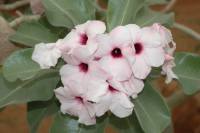
Adenium boehmianum SchinzCommon names: pylgif (Afr.); ouzuwo (Herero).
Occurs in dry rocky places in northern Namibia, southern Angola and Botswana at altitudes of 900-1 200 m. A deciduous succulent shrub up to 1.5 m tall. The swollen stem bears whitish grey branches, covered with dark markings of the old leaf bases. Leaves are 80-140 Í 50-80 mm and folded along the midrib, leathery in texture, paler beneath and arise towards the apex of the branches. The showy, long-tubed flowers are pink to mauve with a darker throat and are hairy on the outside. They appear from November to May (but mostly in autumn, southern hemisphere), usually together with the leaves. A plant has been successfully grown at the Pretoria National Botanical Garden since 1970.

Adenium multiflorum KlotzschCommon names: impala lily, Sabie star, kudu lily ( Eng. ); impalalelie (Afr.).
Grows at low altitudes in hot, dry, sandy or rocky habitats or flats, in open deciduous woodland, from sea level to about 1 200 m. Naturally found in South Africa (northern KwaZulu-Natal, eastern Mpumalanga and Limpopo), eastern Swaziland, Mozambique and Zimbabwe, extending into eastern and western tropical Africa to Malawi and Zambia. Without doubt the most attractive species, somewhat like a miniature baobab, being a deciduous thick-stemmed shrub up to 3 m tall. The large swollen stem, with its smooth grey bark and the branches, contain a watery sap. The leaves are 35-120 Í 15-80 mm, glossy green above, paler beneath, with the midrib and lateral veins distinct above, only the midrib prominent below. They are crowded at the tips of branches, are broadly oval and appear shortly after flowering. Flowers large and showy, white or pale pink with a pink to dark red border, the margins of the petals crisped. Flowering time is May to August. The cigar-shaped fruits split open to release numerous cylindrical, hairy seeds. The name multiflorum is derived from Latin and means many-flowered.
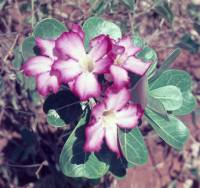
Adenium obesum (Forssk.) Roem. & Schult.Common name: desert rose ( Eng. ).
This extremely variable species occurs mainly north of the equator, extending southwards to Tanzania and northwards to Ethiopia, Somalia, the Arabian Peninsula and the island of Socotra. It occurs across the southern Sahara to western tropical Africa. Many of the forms included in the species have previously been described as separate species. A number of subspecies are recognized. The deciduous, succulent shrubs or small trees are 1-4 m tall. One to a few erect, smooth stems arise from a swollen base and taper towards the apex where several short, spreading to erect branches are produced. The obovate and elliptic leaves are 80-100 Í 30-35 mm, with a short petiole, and are clustered at the tips of the branches. Several flowers are borne in terminal clusters. The corolla is cup-shaped from a short cylindrical base, pink throughout and somewhat darker towards the margins of the lobes, with darker pink stripes in the somewhat paler throat. The corolla lobes are downy, bright cerise at the margins, fading to pink towards the centre. Flowering in winter. The name obesum is derived from the Latin word that means fat or fleshy, referring to the habit of the stems.
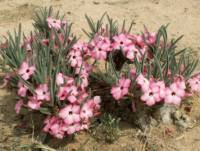
Adenium oleifolium StapfCommon name: ouheip (Afr.).
Found on stony ridges, limestone outcrops or loose sandy or sometimes rocky soils in southeastern Botswana and South Africa (western parts of Northwest and Limpopo and northern parts of the Northern Cape Province), at altitudes of 700- 1 200 m, once recorded from the Warmbad District in Namibia. It is a shrub, 120-400 mm tall, with a large tuberous, mostly buried stem from which the aerial branches arise. The branches are densely pubescent when young, becoming glabrous with age. The olive-green leaves are distinctly long and narrow, 50-110 Í 4-13 mm, and are crowded at the tips of the branches. The terminal inflorescence carries a few pinkish salmon or pale pink to red flowers that appear with the leaves.
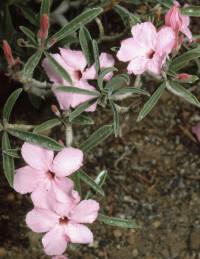
Adenium swazicum StapfCommon names: summer-flowering impala lily, rathbonia (Eng.).
Found in open woodland, usually on sandy brackish flats in South Africa ( Mpumalanga and northern parts of KwaZulu-Natal ), Swaziland and Mozambique at altitudes of 300-400 m. It is a small shrub, up to 650 mm tall, with a large, buried, succulent stem. The stem produces several greenish white or dirty-grey branches. The simple leaves are long, tapering and smooth, 40-130 Í 7-30 mm, and borne in terminal clusters. They are often folded, broader at the apex than at the base and the midrib is prominent beneath. The flowers are pink to deep purple, darker in the throat and appear together with the leaves. Flowering occurs from January to April. A few specimens have been grown in the rockery at the Durban Botanical Garden for many years but have never been seen to set seed. Adenium multiflorum is distinguished from A. swazicum by the upper portion on the inside of the corolla that is hairy and not smooth, by the dark border on the petals and by the flowers that usually appear before the leaves (in A. swazicum the leaves and flowers appear simultaneously).
- Codd, L.E. 1963. Apocynaceae. Flora of southern Africa 26. Botanical Research Institute, Pretoria.
- Codd, L.E. 1987. Adenium obesum. The Flowering Plants of Africa 49: t. 1953.
- Court, D. 2000. Succulent flora of southern Africa, revised edn. Balkema, Rotterdam.
- Dimmit, M.A. & Hanson, C. 1991. The genus Adenium in cultivation. Part 1: A. obesum and A. multiflorum. Cactus and Succulent Journal ( US ) 63: 223-226.
- Dimmit, M.A. & Hanson, C. 1992. The genus Adenium in cultivation. Part 2: A. swazicum, A. boehmianum and A. oleifolium. Cactus and Succulent Journal (US) 64: 110, 111.
- Germishuizen, G. & Fabian, A. 1997. Wildflowers of northern South Africa. Fernwood Press.
- Golding, J. (ed.). 2002. Southern African plant Red Data lists. Southern African Botanical Diversity Network Report No. 14. SABONET, Pretoria.
- Leistner, O.A. (ed.). 2000. Seeds plants of southern Africa : families and genera. Strelitzia 10. National Botanical Institute, Pretoria.
- Oliver, I.B. 1998. Grow succulents. Kirstenbosch Gardening Series. National Botanical Institute, Cape Town.
- Palmer, E. & Pitman, N. 1972. Trees of southern Africa, vol. 3. Struik, Cape Town.
- Pienaar, K. 1992. The South African What flower is that? Struik, Cape Town.
- Plaizier, A.C. 1980. A revision of Adenium Roem. & Schult. and of Diplorhynchus Welw. ex Fic. & Hiern (Apocynaceae). Mededelingen Landbouwhogeschool, Wageningen, Netherlands 80,12: 1-40.
- Pole Evans, I.B. 1921. Adenium multiflorum. The Flowering Plants of South Africa 1: t. 16.
- Pole Evans, I.B. 1923. Adenium oleifolium. The Flowering Plants of South Africa 3: t. 105.
- Pole Evans, I.B. 1937. Adenium swazicum. The Flowering Plants of South Africa 17: t. 664.
- Pole Evans, I.B. 1938. Adenium boehmianum. The Flowering Plants of South Africa 18: t. 701.
- Rood, B. 1994. Uit die veldapteek. Tafelberg, Cape Town.
- Rowley, G. 1999. The Cactus File Handbook 5: Pachypodium and Adenium. Nuffield Press, Oxford.
- Smith, C.A. 1966. Common names of South African plants. Memoirs of the Botanical Survey of South Africa No. 35.
- Van der Spuy, U. 1971. South African shrubs and trees for the garden. Hugh Keartland, Johannesburg.
- Van Wyk, B-E. & Gericke, N. 2000. Peoples plants: a guide to useful plants of southern Africa. Briza Publications, Pretoria.
- Van Wyk, B-E., Van Heerden, F. & Van Oudtshoorn, B. 2002. Poisonous plants of South Africa. Briza Publications, Pretoria.
Plant Type: Shrub, Succulent
SA Distribution:
Soil type:
Flowering season:
PH:
Flower colour:
Aspect:
Gardening skill:
Stunning Varieties of Adenium | Types of Desert Rose
FAQ
How many varieties of Adenium are there?
How to identify an Adenium plant?
How many types of desert rose are there?
What is the lifespan of an Adenium plant?
